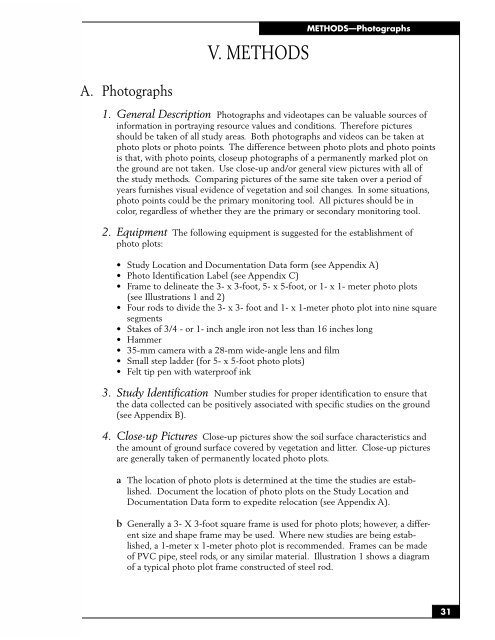Sampling Vegetation Attributes - Natural Resources Conservation ...
Sampling Vegetation Attributes - Natural Resources Conservation ...
Sampling Vegetation Attributes - Natural Resources Conservation ...
Create successful ePaper yourself
Turn your PDF publications into a flip-book with our unique Google optimized e-Paper software.
A. Photographs<br />
V. METHODS<br />
METHODS—Photographs<br />
1. General Description Photographs and videotapes can be valuable sources of<br />
information in portraying resource values and conditions. Therefore pictures<br />
should be taken of all study areas. Both photographs and videos can be taken at<br />
photo plots or photo points. The difference between photo plots and photo points<br />
is that, with photo points, closeup photographs of a permanently marked plot on<br />
the ground are not taken. Use close-up and/or general view pictures with all of<br />
the study methods. Comparing pictures of the same site taken over a period of<br />
years furnishes visual evidence of vegetation and soil changes. In some situations,<br />
photo points could be the primary monitoring tool. All pictures should be in<br />
color, regardless of whether they are the primary or secondary monitoring tool.<br />
2. Equipment The following equipment is suggested for the establishment of<br />
photo plots:<br />
• Study Location and Documentation Data form (see Appendix A)<br />
• Photo Identification Label (see Appendix C)<br />
• Frame to delineate the 3- x 3-foot, 5- x 5-foot, or 1- x 1- meter photo plots<br />
(see Illustrations 1 and 2)<br />
• Four rods to divide the 3- x 3- foot and 1- x 1-meter photo plot into nine square<br />
segments<br />
• Stakes of 3/4 - or 1- inch angle iron not less than 16 inches long<br />
• Hammer<br />
• 35-mm camera with a 28-mm wide-angle lens and film<br />
• Small step ladder (for 5- x 5-foot photo plots)<br />
• Felt tip pen with waterproof ink<br />
3. Study Identification Number studies for proper identification to ensure that<br />
the data collected can be positively associated with specific studies on the ground<br />
(see Appendix B).<br />
4. Close-up Pictures Close-up pictures show the soil surface characteristics and<br />
the amount of ground surface covered by vegetation and litter. Close-up pictures<br />
are generally taken of permanently located photo plots.<br />
a The location of photo plots is determined at the time the studies are established.<br />
Document the location of photo plots on the Study Location and<br />
Documentation Data form to expedite relocation (see Appendix A).<br />
b Generally a 3- X 3-foot square frame is used for photo plots; however, a different<br />
size and shape frame may be used. Where new studies are being established,<br />
a 1-meter x 1-meter photo plot is recommended. Frames can be made<br />
of PVC pipe, steel rods, or any similar material. Illustration 1 shows a diagram<br />
of a typical photo plot frame constructed of steel rod.<br />
31

















